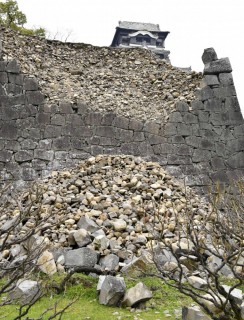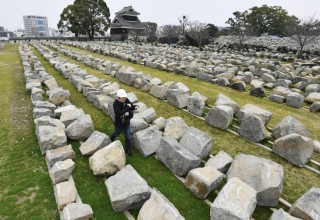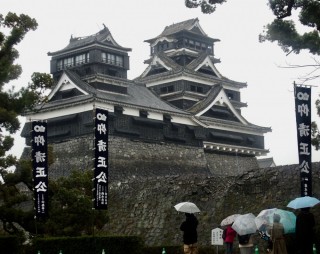Loading
Search
▼ Kumamoto Castle Repairs Expected to Take Decades
- Category:Shrine and Temple
KUMAMOTO – “Warning: No trespassing due to earthquake damage,” bears a sign at Kumamoto Castle, a popular tourist destination in the prefecture, while castle officials make rounds to prevent trespassers.
Strong earthquakes that hit the region last April not only destroyed homes, schools and offices but also cultural properties such as Kumamoto Castle, which was built in 1607 and attracts about 1.7 million tourists a year.
It was the first time the castle had been seriously damaged since it was burned down during the Satsuma Rebellion in 1877.
Visitors at present can only view the castle in limited locations, including Kato Shrine, where they can get closest to the collapsed tenshukaku (castle keep).
“Usually around this season, many tourist buses would arrive, bringing visitors speaking in many different languages, including Chinese, English and Korean. But there are less this year,” said Hideo Kawata, head of Kumamoto Castle’s administration department.
It will take decades to finish restoring the castle, Kawata said.
The worst damage is to the stone wall surrounding the castle, which is expected to take about 20 years to repair.
About 30 percent of the 79,000 sq.-meter wall is damaged, and a further 10 percent has completely collapsed.
To repair the wall, numbers will be allocated to each and every stone that is removed so they can be replaced in the same spot like a jigsaw puzzle.
The castle is also home to 13 important cultural properties designated by the central government, including the castle’s 11 scaffolds and a gate.
Of those, two scaffolds completely collapsed and the roof and walls of a scaffold gate have also been damaged.
But for tourists and history buffs, the damage to the keep may be the most shocking.
The worst damage is to the stone wall surrounding the castle, which is expected to take about 20 years to repair.
About 30 percent of the 79,000 sq.-meter wall is damaged, and a further 10 percent has completely collapsed.
To repair the wall, numbers will be allocated to each and every stone that is removed so they can be replaced in the same spot like a jigsaw puzzle.
The castle is also home to 13 important cultural properties designated by the central government, including the castle’s 11 scaffolds and a gate.
Of those, two scaffolds completely collapsed and the roof and walls of a scaffold gate have also been damaged.
But for tourists and history buffs, the damage to the keep may be the most shocking.
Although it’s not designated as an important cultural property, the keep, rebuilt in 1960 in concrete, is regarded by many as a symbol of the castle.
Well aware it’s a key tourist attraction, the city of Kumamoto plans to restore part of the castle keep within two years in time for the Women’s Handball World Championship and Rugby World Cup in Japan in 2019.
The keep is made of two parts — a larger keep and a smaller one — with two more years needed to finish repairs on the larger, including barrier-free features such as an elevator.
“Nagoya Castle and Osaka Castle have elevators, but because they are located outside, they disturb the scenery. That’s why we decided to build the elevator inside Kumamoto Castle,” said Kawata.
Stairways from the castle entrance to the keep will also be rebuilt as ramps, said Kawata.
According to Kumamoto Castle’s official website, some stairways in the castle were built to different lengths in what was originally intended to make it difficult for enemy samurai to walk when they entered the premises.
Well aware it’s a key tourist attraction, the city of Kumamoto plans to restore part of the castle keep within two years in time for the Women’s Handball World Championship and Rugby World Cup in Japan in 2019.
The keep is made of two parts — a larger keep and a smaller one — with two more years needed to finish repairs on the larger, including barrier-free features such as an elevator.
“Nagoya Castle and Osaka Castle have elevators, but because they are located outside, they disturb the scenery. That’s why we decided to build the elevator inside Kumamoto Castle,” said Kawata.
Stairways from the castle entrance to the keep will also be rebuilt as ramps, said Kawata.
According to Kumamoto Castle’s official website, some stairways in the castle were built to different lengths in what was originally intended to make it difficult for enemy samurai to walk when they entered the premises.
Although restoring Kumamoto Castle will be a long-term project, the city will occasionally open certain areas of the landmark to tourists as construction progresses.
For two days in March and three days earlier this month, the Miyukizaka area of the castle, a famous spot for cherry blossom-viewing, was opened to the public.
“The castle is especially famous for the cherry blossom trees. As construction progresses and safety is guaranteed, we are considering allowing the public to come in,” said Kawata. “We would like to do the reconstruction so that visitors can in some way see the larger castle keep by early fiscal 2019.”
For two days in March and three days earlier this month, the Miyukizaka area of the castle, a famous spot for cherry blossom-viewing, was opened to the public.
“The castle is especially famous for the cherry blossom trees. As construction progresses and safety is guaranteed, we are considering allowing the public to come in,” said Kawata. “We would like to do the reconstruction so that visitors can in some way see the larger castle keep by early fiscal 2019.”
- April 14, 2017
- Comment (0)
- Trackback(0)





